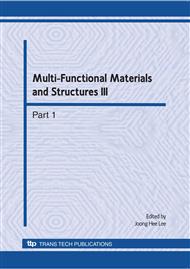p.659
p.663
p.667
p.671
p.675
p.679
p.683
p.687
p.691
Fabrication of Ag Nanoparticles Colloids by Pulsed Laser Ablation in Liquid
Abstract:
Ag nanoparticles colloids have been fabricated by pulsed laser ablation in various liquids. The particle size, morphology and absorption spectroscopy of the obtained nanoparticles colloids were characterized by ultraviolet to visible (UV-Vis) spectrophotometer and transmission electron microscopy (TEM), the average diameter and its distribution were analyzed by Image-ProPlus software. The results showed that the Ag nanoparticles with best characterization are those produced at the repetition rate of 10Hz and laser fluence of 4.2J/cm2 by ablating for 7.5min in the distilled water, with the least average diameter(D=14.48 nm), the narrowest distribution of particles size (=25.8 nm) and more homogeneous morphologies. The effects of experimental conditions on the silver nanoparticles colloid can be explained by fragmentation and melting induced aggregation of colloidal particles by self-absorption of laser pulses.
Info:
Periodical:
Pages:
675-678
Citation:
Online since:
August 2010
Authors:
Keywords:
Price:
Сopyright:
© 2010 Trans Tech Publications Ltd. All Rights Reserved
Share:
Citation:


